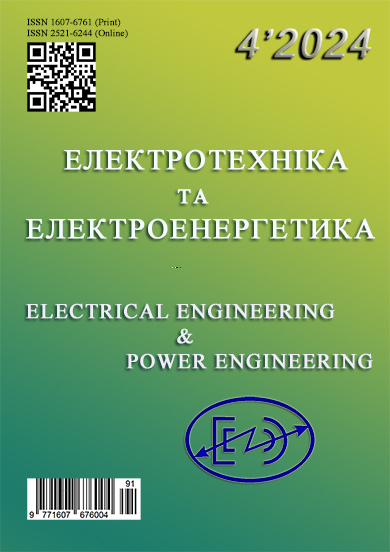Method for identifying a connection with a metering defect among multiple connections on a single busbar section
DOI:
https://doi.org/10.15588/1607-6761-2024-4-2Keywords:
electricity metering, electricity meter, balance method, imbalance increase, mutual correlation coefficient, Fisher's criterionAbstract
Purpose. The purpose of this work is to develop a methodology for identifying a defective connection on a single medium- or low-voltage busbar section among several parallel connections.
Methodology. As is known, from three to two dozen connections can be powered simultaneously from the busbar section of the main step-down substation with a higher voltage of 35÷154 kV, a dead-end substation with a medium voltage of 10 (6) kV or a transformer substation with a voltage of 10 (6)/0.4 kV.A metering device defect on one of these connections can only be detected using the balance method (where a metering device, usually for commercial purposes, is installed at the busbar section input, and each outgoing connection from the busbar section is also equipped with an electricity meter). The search for a defective metering device is carried out by inspecting all metering devices for each connection. Among them, the defective device is identified. However, this procedure often takes a significant amount of time, requires the implementation of organizational and technical measures when working in operational electrical installations, and can lead to emergency disconnections of connections due to voltage circuit shorting or current circuit breaking caused by incorrect or erroneous actions of personnel.
Findings. Four main types of defects in accounting schemes are identified. It is shown that the imbalance between commercial and technical accounting can be used to identify defects in the tire section. Criteria for the rapid identification of defective connections based on statistical methods such as correlation analysis and one-factor analysis of variance are developed.
Originality. In contrast to the existing approach, the sequence is proposed and the criteria for finding a connection with a metering defect are developed using the analytical method. As a result, it will be necessary to replace the metering device or device only at one connection connected to the busbar section with a defect in the metering circuits. The analytical method is based on the processing of metering data and the calculation of several statistical coefficients.
Practical value. The proposed methodology enables the rapid identification of a defective metering device using an analytical method. It ensures fast and accurate detection of defective connections on the busbar section, helping to avoid emergency situations and energy losses. This makes the methodology valuable for industrial enterprises with high energy consumption.
References
Appendix 10 to the Agreement between the members of the Wholesale Electricity Market of Ukraine. In-struction on the Procedure for Commercial Electricity Metering. Kyiv, 2013.
Lukyanenko, I. G., Krasnikova., L. I. (1998). Econo-metrics: Textbook. Kyiv: Knowledge Society, KOO, 494.
Gapon, D. A., Hryb, O. H., Karpaliuk, I. T., Rudevich, N. V. (2021). Automated systems for metering and quality control of electricity in power supply systems, Visn. Nat. Tech. Univ. “KhPI.” Ser.: Power Engineer-ing: Reliability and Energy Efficiency, No. 2(3), 54–58.
Prakhovnyk A. V., Tesyk Yu. F., Zharkin A. F., Novskyi V. O.,. Hryb O. H, Kalinchyk V. P., Karasin-skyi O. L., Dovhaliuk O. M., Lazurenko O. P., Khadakivskyi A. M., Vasylenko V. I., Svetelik O. D., Hryb O. H.(2012). Automated systems for metering and quality control of electricity: Monograph. Kharkiv: Ranok-NT, 516.
Hutaranko, V. P., Koval, S. A. (2018). Electricity me-tering and control in industrial enterprises. Kyiv: Tekhnika, 220.
Sydorenko, M. I. (2019). Energy consumption moni-toring in industrial electrical installations. Kharkiv: Osnova, 180.
Petrenko, A. M., Tarasov, V. I. (2020). Analysis of energy metering defect detection methods. Ener-getyka Ukrainy, No. 2, 34–40.
Korshunov, V. O. (2021). Criteria for assessing imbal-ances in power systems. Scientific Notes on Energy. Vol. 12, No. 3, 55–60.
Zhang, X., Li, H., Wang, Y. (2019). Electricity con-sumption monitoring and fraud detection using IoT technologies. IEEE Transactions on Smart Grid, Vol. 10, No. 3, 1234–1242.
Kucherenko, S. H. (2020). Application of correlation analysis for detecting anomalies in energy consump-tion. Electrical Engineering and Automation. No. 1, 67–72.
Schneider Electric White Paper. (2021). Energy moni-toring and anomaly detection in industrial power sys-tems. Schneider Electric.
Polyakov, D. M. (2021). Development of energy monitoring technologies. Energy and Automation. No. 4, 88–94.
ABB Group. (2021). Automated solutions for energy loss detection. ABB Technical Publications.
Kumar, R., Singh, J. (2021). Advanced metering in-frastructure in modern power grids. Energy Reports, Vol. 7, 1123–1130.
Ukrainian Energy Forum. (2022). Modern challenges in energy metering. Conference proceedings.
Kwon, J., Lee, K. (2021). Big Data analytics for anomaly detection in energy systems. Energy Sys-tems Research. Vol. 15, No. 3, 65–78.
Downloads
Published
How to Cite
Issue
Section
License
Copyright (c) 2025 A.V. Voloshko, Y.S. Bederak, Y.V. Kozlovskyi

This work is licensed under a Creative Commons Attribution-ShareAlike 4.0 International License.
Creative Commons Licensing Notifications in the Copyright Notices
Authors who publish with this journal agree to the following terms:
Authors retain copyright and grant the journal right of first publication with the work simultaneously licensed under aCreative Commons Attribution License that allows others to share the work with an acknowledgement of the work's authorship and initial publication in this journal.
Authors are able to enter into separate, additional contractual arrangements for the non-exclusive distribution of the journal's published version of the work (e.g., post it to an institutional repository or publish it in a book), with an acknowledgement of its initial publication in this journal.
Authors are permitted and encouraged to post their work online (e.g., in institutional repositories or on their website) prior to and during the submission process, as it can lead to productive exchanges, as well as earlier and greater citation of published work.

